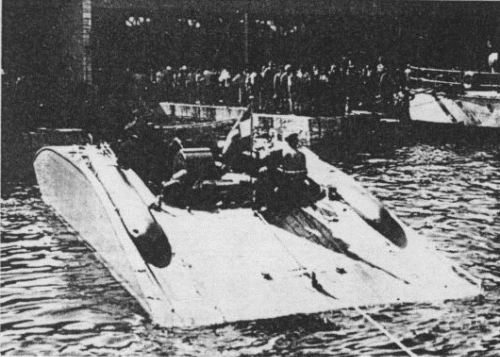
NAVYPEDIA
 Support the project with paypal
Support the project with paypal
Photo

1915
Ships
| Names | Builders | Commissioned | Losses | Transfers | Discarding |
|---|---|---|---|---|---|
'Versuchsgleitboot' |
Marinearsenal Pola: 'Versuchsgleitboot' |
10/1915: 'Versuchsgleitboot' |
none |
none |
10/1916: 'Versuchsgleitboot' |
Technical data
| Displacement normal, t | 7.6 |
|---|---|
| Displacement full, t | |
| Length, m | 13.0 |
| Breadth, m | 4.00 |
| Draught, m | 0.4 |
| No of shafts | 2 + 1 vertical fan |
| Machinery | 4 Austro-Daimler aero-engines + 1 Austro-Daimler aero-engine |
| Power, h. p. | 480 + 65 |
| Max speed, kts | 32.6 |
| Fuel, t | petrol |
| Endurance, nm(kts) | 120(30) |
| Armament | 1 x 1 - 8.80, 2 - 356 TC (stern, nose-first) |
| Complement | 5 |
Standard scale images

1915
Graphics
Project history
The origin of the Versuchsgleitboot goes back to a private proposal of Lt Cdr Müller-Thomamuehl concerning a hovercraft, the actual experimental prototype being a modified design with a wooden rectangular hull of spindle-shaped design, with the bottom divided, by a vertical step, into planing and hover sections. To ensure eddyless air-injection a swallow tail-shaped duct was situated at the vertical step. The fan was situated in the forward section of the rectangular hull and produced an air-cushion under the hovering part of the bottom. Skirts at both sides prevented the air from escaping but there were no skirts at stem and stern. The main armament consisted of two torpedoes, each in an open chute arranged for launching over the stern by means of compressed air. Three small 6kg (131b) DCs were added later.
Modernizations
1916: + 3 DC
Naval service
Launched on 1 September 1915 it underwent extensive trials with different propeller types but was considered unworthy of further development due to a number of technical deficiencies. What really was needed was a fast, armoured MTB, so the Versuchsgleitboot was cannibalized and finally scrapped during the following years.
 HOME
HOME FIGHTING SHIPS OF THE WORLD
FIGHTING SHIPS OF THE WORLD AUSTRIA-HUNGARY
AUSTRIA-HUNGARY COASTAL FORCES
COASTAL FORCES 'Versuchsgleitboot' experimental air-cushion boat (1915)
'Versuchsgleitboot' experimental air-cushion boat (1915)
